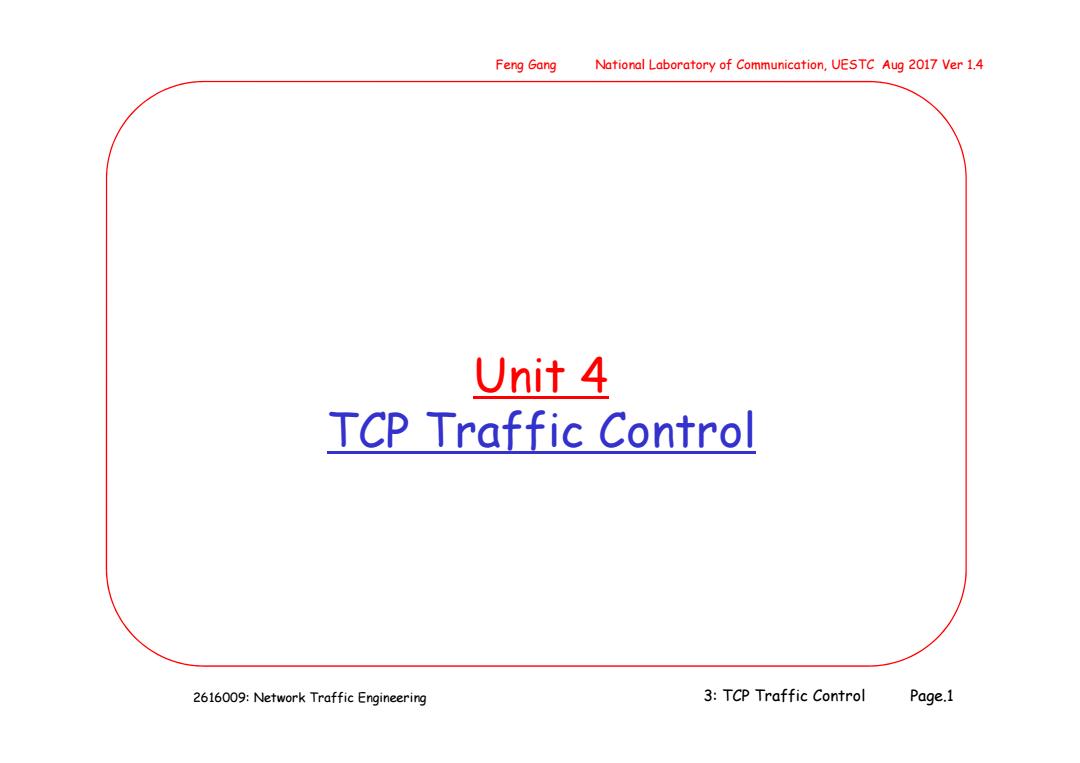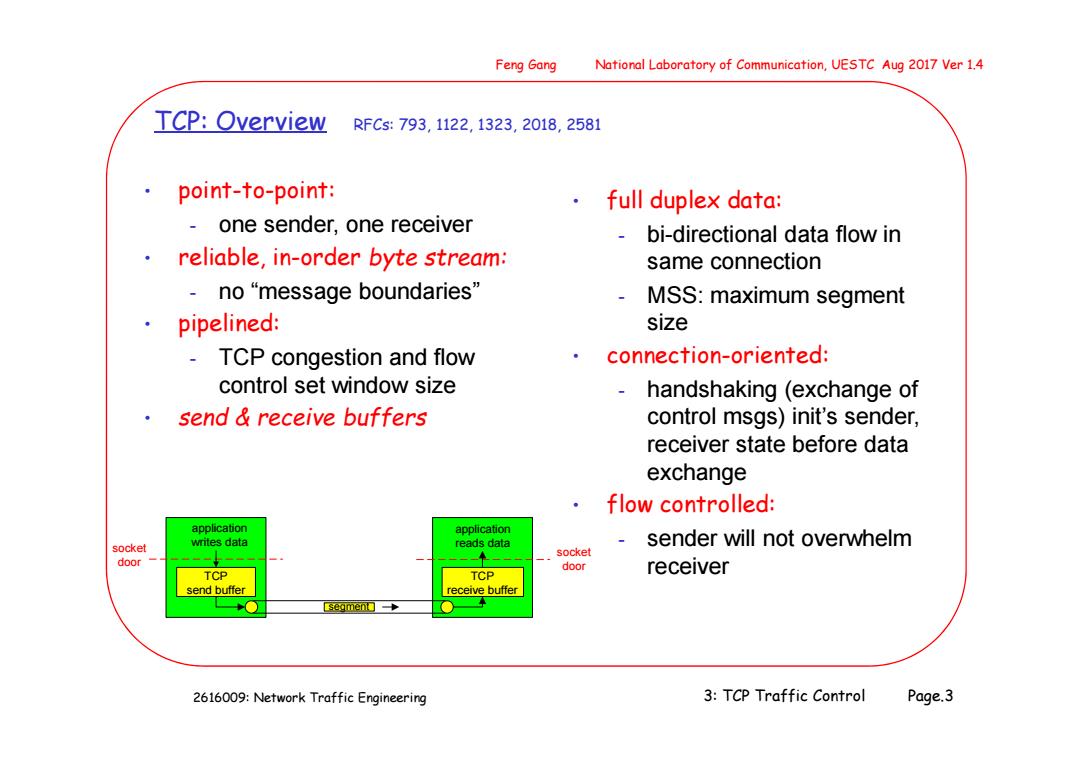
Feng Gang National Laboratory of Communication,UESTC Aug 2017 Ver 1.4 Unit 4 TCP Traffic Control 2616009:Network Traffic Engineering 3:TCP Traffic Control Page.1
2616009: Network Traffic Engineering Feng Gang National Laboratory of Communication, UESTC Aug 2017 Ver 1.4 3: TCP Traffic Control Page.1 Unit 4 TCP Traffic Control

Feng Gang National Laboratory of Communication,UESTC Aug 2017 Ver 1.4 Roadmap Review of TCP TCP flow control and congestion control TCP over wireless Case study:New Snoop for TCP in Wireless networks 2616009:Network Traffic Engineering 3:TCP Traffic Control Page.2
2616009: Network Traffic Engineering Feng Gang National Laboratory of Communication, UESTC Aug 2017 Ver 1.4 3: TCP Traffic Control Page.2 • Review of TCP • TCP flow control and congestion control • TCP over wireless • Case study: New Snoop for TCP in Wireless networks Roadmap

Feng Gang National Laboratory of Communication,UESTC Aug 2017 Ver 1.4 TCP:Overview RFCs:793,1122,1323,2018,2581 point-to-point: full duplex data: one sender,one receiver bi-directional data flow in reliable,in-order byte stream: same connection -no“message boundaries” MSS:maximum segment pipelined: size TCP congestion and flow connection-oriented: control set window size handshaking (exchange of send receive buffers control msgs)init's sender, receiver state before data exchange flow controlled: application application writes data sender will not overwhelm socket reads data socket door ----- ---个- door TCP TCP receiver send buffer receive buffer ● [segment 2616009:Network Traffic Engineering 3:TCP Traffic Control Page.3
2616009: Network Traffic Engineering Feng Gang National Laboratory of Communication, UESTC Aug 2017 Ver 1.4 3: TCP Traffic Control Page.3 TCP: Overview RFCs: 793, 1122, 1323, 2018, 2581 • full duplex data: - bi-directional data flow in same connection - MSS: maximum segment size • connection-oriented: - handshaking (exchange of control msgs) init’s sender, receiver state before data exchange • flow controlled: - sender will not overwhelm receiver • point-to-point: - one sender, one receiver • reliable, in-order byte stream: - no “message boundaries” • pipelined: - TCP congestion and flow control set window size • send & receive buffers socket door TCP send buffer TCP receive buffer socket door segment application writes data application reads data

Feng Gang National Laboratory of Communication,UESTC Aug 2017 Ver 1.4 TCP Flow Control flow control- sender won't overrun receiver's buffers by transmitting too much,too fast Closed-loop Cumulative acknowledgements Implicit an acknowledgement ack's all ·Dynamic window contiguously received data ·End-to-end Coordination between one sender and one receiver Features Per conversation or flow,not no support from routers network-wide increase if no loss - window decrease if loss additive increase multiplicative decrease 2616009:Network Traffic Engineering 3:TCP Traffic Control Page.4
2616009: Network Traffic Engineering Feng Gang National Laboratory of Communication, UESTC Aug 2017 Ver 1.4 3: TCP Traffic Control Page.4 TCP Flow Control • Closed-loop • Implicit • Dynamic window • End-to-end • Features - no support from routers - increase if no loss - window decrease if loss - additive increase multiplicative decrease sender won’t overrun receiver’s buffers by transmitting too much, too fast flow control • Cumulative acknowledgements – an acknowledgement ack’s all contiguously received data • Coordination between one sender and one receiver - Per conversation or flow, not network-wide

Feng Gang National Laboratory of Communication,UESTC Aug 2017 Ver 1.4 TCP Round Trip Time and Timeout Q:how to set TCP timeout Q:how to estimate RTT? value? 。 SampleRTT:measured time from ·longer than RTT segment transmission until ACK receipt - note:RTT will vary ignore retransmissions, too short:premature timeout cumulatively ACKed segments unnecessary SampleRTT will vary,want estimated retransmissions RTT "smoother" 。 too long:slow reaction to use several recent measurements, segment loss not just current SampleRTT 2616009:Network Traffic Engineering 3:TCP Traffic Control Page.5
2616009: Network Traffic Engineering Feng Gang National Laboratory of Communication, UESTC Aug 2017 Ver 1.4 3: TCP Traffic Control Page.5 TCP Round Trip Time and Timeout Q: how to set TCP timeout value? • longer than RTT - note: RTT will vary • too short: premature timeout - unnecessary retransmissions • too long: slow reaction to segment loss Q: how to estimate RTT? • SampleRTT: measured time from segment transmission until ACK receipt - ignore retransmissions, cumulatively ACKed segments • SampleRTT will vary, want estimated RTT “smoother” - use several recent measurements, not just current SampleRTT